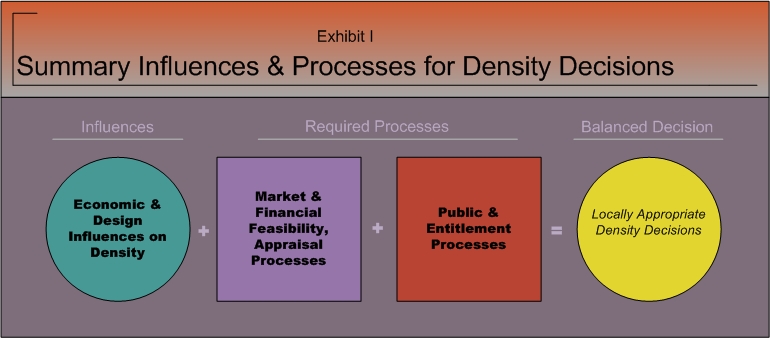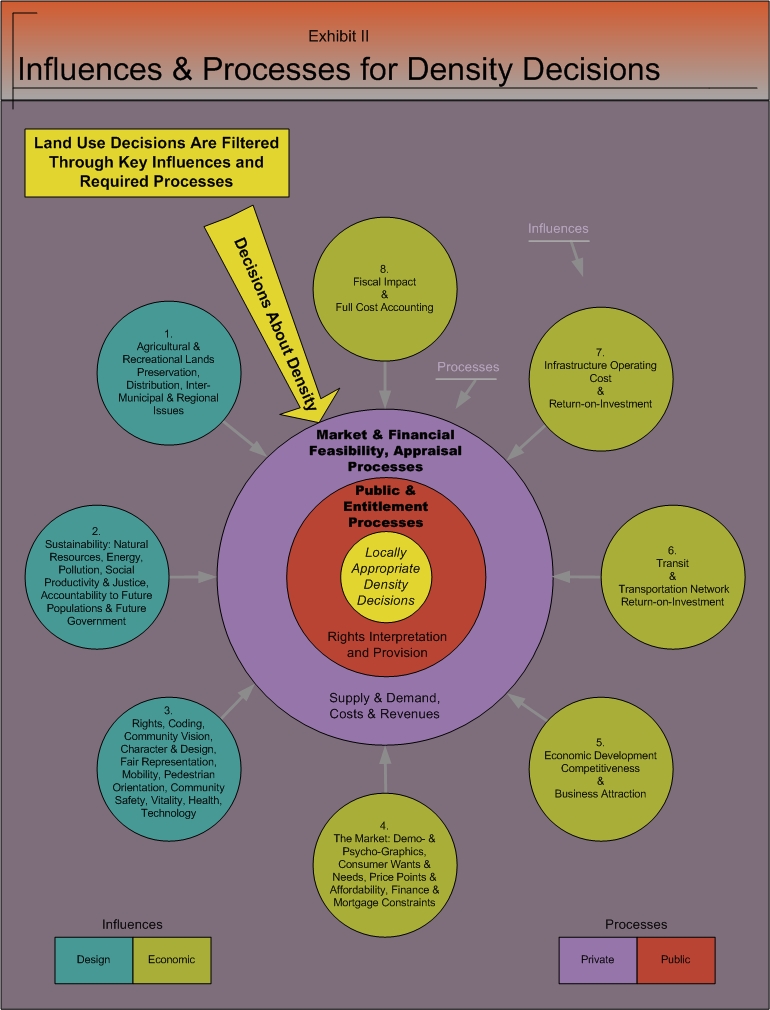How Much Density?
By Mark Smith
We are sometimes asked to explain ‘what is density?’ and ‘what is our position on density?’ In our view, the appropriate type and degree of density is locally and regionally determined, through community engagement and feasibility analysis. Planning may include a situational assessment of the economic and design influences on density, market and financial feasibility, and public and entitlement processes. See a summary of these influences and processes in Exhibit I and more detail in Exhibit II at the end of this post. Density is best viewed in relation to the marketplace over time, instilling mechanisms for density to coevolve with marketplace demand in selected locations.
Our mission includes helping clients optimize and implement their desired level of density, with particular focus on planning methods for implementing density over time, corresponding with evolution of marketplace demand. When uninhibited, market demand increases in most locations, which provides opportunity to increase density over time with a mix of residential and commercial uses.
But in real estate there are obstacles to the natural evolution of a community:
- Zoning that only allows low density and does so without mechanisms for an evolution of community and density where it would be market supported and financially beneficial, including for municipalities.
- Euclidian type zoning approaches wherein uses are separated, which can use land inefficiently and causes need for more travel in daily life.
- The presumed fixed nature of real estate assets.
- Community resistance to density by residential and commercial owners and tenants that do not want to be in dense urban development or poorly planned density.
Our adopted mission and assembled skills allow us to help clients optimize and implement their density decisions.
We are also asked ‘are we density advocates?’ The answer is yes, in appropriate locations, because we believe that there are economic, social, and environmental benefits that result from density being an appropriate portion of city and regional urban development. Many of these benefits are still too-little understood both in terms of their magnitude as well as how to accomplish density in ways that maximize benefits and minimize costs. Thus, we see there is a community need and related business opportunity to optimize density decisions, and implement them. Specifically, we aim to help public and private sector clients:
- Identify market-based demand for density, including evolution of demand as communities mature.
- Create locations for density that support a higher return on initial infrastructure investment for cities and other government bodies.
- Reduce ongoing cost of municipal operations.
- Provide motivation and profit for developers to accomplish well-planned density.
- Support economic development by helping create more vital, attractive places, and add to the building area within a municipality.
GOING FORWARD
Prior to the Great Recession, cities had typically become conditioned by growth and related fees. Municipal revenues from property taxes, retail sales, and business taxes were high whereas they are now considerably reduced, bringing new economic realities to municipalities.
Because of the new level of financial stress, and the prospect of it being prolonged, we foresee a movement toward the adoption of what businesses call ‘full cost accounting’ for urban development and management on behalf of both public and private sector participants. This will include better incorporation of marketplace trends over time and more accurate accounting costs and revenues. The goal is to reduce costs and to increase the ROI on investments needed.
Our advocacy is economic, not political. As market economists, we acknowledge the variety of market segments and people’s right to choose community type. Currently, higher densities represent a very small percent of urban development, particularly in the sprawling suburbs built in the past 50 years across America, which are almost entirely low density. Incomplete accounting of the cost of building and servicing low-density infrastructure has sustained a costly and inefficient chapter in urban management.
We support the pedestrian shed as an appropriate organizing principal for urban planning and development. The pedestrian shed—which advocates providing a majority of daily needs of people within walking distance of residences—can be an effective neighborhood planning model with which density relationships can be created.
A mix of higher and lower density is often the right balance. We are not suggesting that in every location density must evolve. Indeed, part of the systemic benefit of density is its relationship to and support of lower density development, such as single family housing, and undeveloped land, such as agriculture, recreation, and ecologically preserving open space. In most cases, a well-balanced community or city will contain a range of household and business types suggesting that a range of land development patterns may be optimal.
ANOTHER LAYER OF DENSITY POLITICS
Finally, we wish to acknowledge the heightened debate about the appropriateness of density, and about motivations for density. Critics of density often imply that density advocates propose ‘wall-to-wall’ density. Actually, while we at Planned Densification advocate density, we do so where we believe it is beneficial economically, socially, and environmentally—and supported by the marketplace. Exhibit II presents details about influences and processes that affect density decisions.
Balancing these influences and the required processes of real estate development results in–let us say it again–a full range of densities in a community, with higher density often representing a small amount of total development. And although the amount of density we might advocate in a city may be small compared with the city’s total land area, the increases in density in locations that correspond with considerable municipal investment in infrastructure, transportation, and other assets can make important positive impact toward lower costs and higher return on city investments—meaning a city can accomplish more with its increasingly limited income, and reduce needs for addition taxation and revenue generation techniques. Each dollar of municipal funding needs to service more of our urban land and infrastructure.


